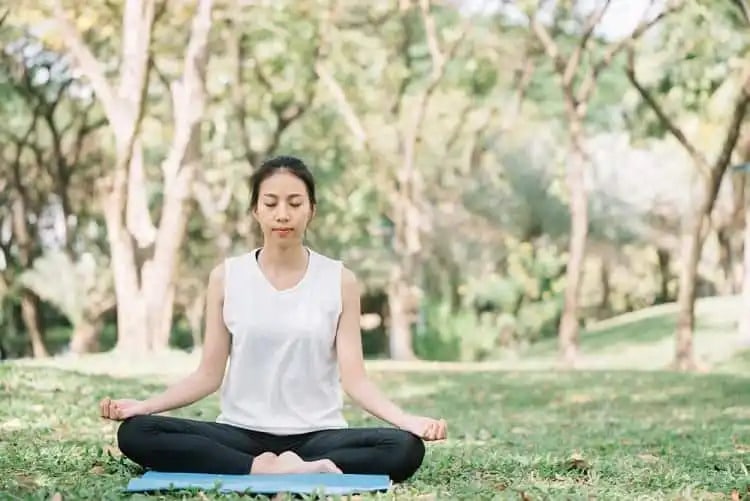Siddha, which means perfect, and asana, which means stance, are the two words that makeup Siddhasana. It is also referred to as the ideal stance or the completed pose for this reason. It is known as an accomplished stance since it may help people overcome their obstacles. Due to the potential for liberation, it is also known as the liberation position or muktasana. Siddhasana Benefits
Who can perform Siddhasana?
Siddhasana is a basic stance that may be performed by many people. These consist of:
- Youngsters
- Seniors
- Siddhasana is an option for those who desire to incorporate meditation into their yoga routine.
- Expectant mothers
How To Perform Siddhasana?
The steps involved in siddhasana are as follows:
- Place your legs in front of your torso while seated on a mat or the ground.
- Bend your right leg so your foot’s sole is up against the inside of your left thigh.
- Place the heels of your right leg against the perineum, which is the region between the genitals and the anus.
- Next, flex your left leg. The toe and outside edge of your left foot should be pushed into the space between your right calf and thigh muscles.
- You can widen this region if necessary by extending your hands or momentarily shifting the posture of your right leg.
- Next, cross your left ankle over your right ankle such that the ankle bones are in contact and the heels are positioned so that the genitalia are between the two heels.
- With your left heel, push the pubic area. If it is difficult, you can place the left heel close to the pubis.
- Next, insert your right toe into the opening between your left thigh and calf.
- After that, make your body comfy by adjusting it.
- Put your weight on the right heel. Press the heel down once the body is in a comfortable position. The left heel should now be over the right and the knees should be touching the ground. Legs become immobilized.
- Maintain spinal straightness during the procedure.
- Place your hands on your knees in the gyan position, the chin mudra (touch your index finger with the tip of your thumb), or the chinmaya mudra (thumb and index finger together).
- Next, relax your body by closing your eyes.
- As long as it’s comfortable for you, you can hold this position for ten minutes.
- Try the sukhasana stance to warm up for this one.
Siddhasana Benefits
The following are some of the Siddhasana Benefits:
Siddhasana Benefits of physical activity for psoriasis
An inflammatory skin disorder called psoriasis can remit and relapse. Yoga poses like Siddhasana Benefits, according to Singh et al. (2015), assist lower inflammation in the body. Additionally, it is said to possibly preserve immune system balance and alleviate stress. Psoriasis management may benefit from this. But kindly visit a doctor for the right care. The best way to do this is with a trainer’s guidance.
Siddhasana benefits for the hip joint
Hip immobility can lead to a variety of issues in daily living. Therefore, it is essential to pay attention to hip movements and flexibility to prevent movement limitations. According to a study by Gurmule et al., siddhasana could improve the ligaments of hip joints, which connect tissues to bones and joints. Siddhasana Benefits and increases flexibility and stretches the joint muscles may also be beneficial. The effects of siddhasana on the hip joints in the elderly or those with hip issues, however, require further study. Therefore, before attempting siddhasana while having hip joint problems, please speak with a doctor.
Siddhasana Benefits for Mental Health
Yoga poses like siddhasana Benefits, according to research by Kaushal from 2016, help people manage their stress, tension, and anxiety. It may influence and impact a person’s response to stress as well as their attitude toward stress. This might encourage calmness and relaxation.
Siddhasana benefits for digestive issues
According to Khadkutkar et al. (2012), yoga poses like siddhasana can help treat amalpitta, a digestive condition brought on by hyperchlorhydria (increased acid production). A poor diet and way of life lead to amalpitta. Poses like Siddhasana and others may facilitate better digestion and elimination. The balance of pitta in the stomach may be enhanced through improved digestion. However, for a diagnosis and course of therapy, you could see a doctor. It is preferable if you follow your trainer’s instructions.

Siddhasana benefits for blood pressure
Siddhasana and other poses have been shown by Pal et al. (2013) to be capable of controlling blood pressure. Systolic blood pressure in the patients was shown to drop after three months of yoga practice. Systolic blood pressure is the force that the blood places on the artery walls. This suggests that siddhasana may play a function in controlling blood pressure. Siddhasana is useful, but you shouldn’t rely solely on it—more analysis is required to determine just how efficient it is. Therefore, please visit a doctor for appropriate care. The best way to do this is with a trainer’s guidance.
Siddhasana benefits for the lungs
Siddhasana and other yoga postures significantly reduced breath hold duration (BHT) and oxygen use, according to a 2013 study by Pal et al. This might facilitate better breathing. Additionally, it was mentioned that yoga positions can boost anaerobic power, generating energy even with little oxygen used to do tasks with the greatest possible speed. As a result, it might contribute to the person’s respiratory function being improved. However, for a correct diagnosis and course of therapy, you must see a doctor.
Additional Siddhasana Benefits:
The following are some more Siddhasana Benefits:
- It might enhance blood flow to the lumbar and abdominal areas.
- The lower spine may also be toned.
Queen of fitness and her diet plan
Who should stay away from Siddhasana?
Despite of Siddhasana Benefits, Siddhasana yoga asana should be avoided by the following groups of people:
- Individuals who suffer knee, ankle, or hip injuries.
- People who have arthritis.
- Those who experience sciatica discomfort.
- Pregnant ladies should only strike this stance after consulting their doctor.
- People who have the flu, a cold, or a fever.
- People who are now going through a lot of stress or anxiety.
https://blog.cult.fit/articles/siddhasana-accomplished-pose-meaning-how-to-do-it-benefits-postures
What are some Siddhasana variations?
You might try the following variants of the Siddhasana pose:
1. Jalandhar Bandha
One of the best asanas for reviving your energy channels and inducing a deep state of concentration is this one.
Procedure of Jalandhar Bandha
- Assume the Siddhasana position and begin to breathe deliberately.
- Slightly tighten the throat to simulate swallowing.
- Press your chin downward while bringing it up against your spine.
- Maintain this pose for however long it feels comfortable.
- To get back to the starting posture, ease your throat, lift your chin, and let out a deep breath.
2. Ardha Siddhasana
Ardha Siddhasana, also referred to as the Half-Perfect Pose, is a simpler version of the classic Siddhasana. People with restricted range of motion or improperly open hip joints benefit from Ardha Siddhasana. The Ardha Siddhasana Isha yoga pose has significance, just like the standard Siddhasana pose.
Procedures for Ardha Siddhasana
- Keep your legs close to one another when sitting comfortably.
- Place your left foot where the Siddhasana steps instruct.
- Instead of placing your right foot over your left foot, place it directly in front of the left foot to enter the Ardha Siddhasana position.
Conclusion
Siddhasana is a yoga stance for beginners that stimulates people’s paranormal talents. Siddhasana, or seated position yoga, may be useful for enhancing blood flow to the lower back or other lower body parts. If you encounter adverse effects while performing the siddhasana, kindly consult a doctor. Try to execute this stance while the trainer is guiding you.



